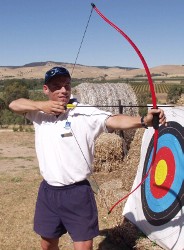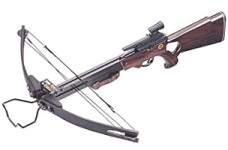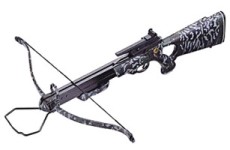
A Short History of the Bow and Arrow
- The use of bow and arrows for hunting and war goes back a very long way. As early as 25,000 BC, arrows with fire-hardened points or flint arrowheads tied on with sinew were used with simple bows to kill game. In 5000 BC the Egyptians used the bow for hunting and in warfare against the Persians.
- By 2800 BC the first composite bow was in use; it was made from wood and held together with animal sinew and glue. The unstrung bow, shaped like a 'C', required two people to string it and used bowstrings made from sheep's intestines. The arrows were very light and could be shot over 300 metres; armour worn by the enemy could not protect them.
- In 434 AD, Attila the Hun's army used composite recurve bows from horseback with deadly results.
- In 1066 AD at the Battle of Hastings, King Harold of England was defeated primarily because of the large number of archers in the opposing army.
- In 1346 AD at the Battle of Crecy, Edward III of England led his army against the French. A French force of crossbowmen attacked, but the English archers using longbows showered them with arrows before they could reload, and then did the same thing to the French cavalry. 1,542 French knights were killed, with only 50 English killed.
- In 1588 AD, 10,000 soldiers in the English fleet, armed with muskets, defeated the Spanish Armada. This marked the beginning of the decline of the bow and arrow in warfare. In 1595 all bows in England were ordered to be exchanged for muskets.
- In 1969, Holless Wilbur Allen was given a patent for his invention of the compound bow. Mr. Allen was a bowhunter who was disappointed with the hunting bows of the day; he decided to design a new type of bow for hunting. His original design had 'wheels' that were triangular shaped.

A bow is a device that converts slow and steady human force, applied over a distance, into stored mechanical potential energy. This energy, stored in the limbs of the bow, is converted into kinetic energy when the bowstring is released, and most of that kinetic energy is transfered to the arrow.
A recurved bow, instead of being straight pieces of wood when unstrung, has limbs whose tips are curved away from the archer ... they
are 'recurved'. When the bow is strung, there is still lots of curve left in the limbs, allowing for more energy to be stored.
In a compound bow, when the archer pulls back the string, the potential energy is transferred through the string to cams or pulleys at either end of the bow. These pulleys, which are a type of simple machine, add mechanical advantage to help bend the limbs of the bow with less applied force ... or allow you to bend them more and store more energy, with the same force. As with an ordinary bow, the limbs store the potential energy until the arrow is released.
Types of Bows
Bows can be made from a variety of materials. Traditional English bows were made from wood, primarily yew. Modern bows can also be made from aluminum or fiber glass. Crossbow limbs are sometimes made from spring steel.
- Composite Bow
- The composite bow is a regular bow that is able to store more energy because it is made from two or more types of materials. The back of the bow is made of a material that resists being stretched, while the front is made of a material which resists being compressed. The two materials work together to make a stronger bow that can store more energy.

- Longbow
- The longbow is a bow that is longer than normal. In the past, archers have used longbows that were taller than the archers themselves. The added length increases the distance you can draw the string, allowing you to store more energy, which makes the arrow go farther. Archers would use the bow to deliver a shower of unaimed arrows upon the advancing enemy.
The longbow has very narrow limbs, and is very light and stable; it can be easily shot while held at an angle.

- Recurve Bow
- A recurve bow has tips that curve away from the archer, and is usually also a composite bow. It allows more spring force over the first few inches of draw, and more energy to be stored. It is the most commonly used bow in the Olympics and among sporting archers.

- Compound Bow
- A compound bow uses mechanical levers, pulleys, or cams to produce more stored energy with less work done. Another benefit of the compound bow is that the archer does not have to hold the full 'pull weight' when the bowstring is drawn back; eccentric cams at the tips allow a hunter to hold the bow at full draw for a longer period of time.

Other types of bows include the self bow, which is the simplest kind ... a regular bow made from one material, usually wood, that is fairly
straight. A reflex bow is a dramatically curved recurve bow where the whole bow flexes away from the archer like a backwards 'C' when unstrung.
The crossbow sits sideways on a frame, and sometimes uses a mechanical winch to draw the limbs, which might be spring steel; these can store a large quantity of energy. The rifle-like body allows careful aiming of the short arrows. Crossbows can come in a variety of types. below are examples of a compund crossbow and a recurve crossbow.
 
Arrows
An arrow is made up of five basic parts:
- Arrowhead: This is the part that hits the target and does the damage.
- Inserts/Outserts: The part where the arrow and the arrowhead are fastened.
- Shaft: The body of the arrow.
- Fletching: These are the feathers which keep the arrow stable in flight.
- Nock: This is the piece which holds the arrow to the bowstring.

Arrows also can be made from a variety of materials. Each type has its pros and cons:
- Wood is cheap, but arrows made from wood can be imperfect, and are liable to break or warp. Cedar arrows resist warping; they're heavier and move slower, but penetrate better. Wood arrows are usually used by beginners, or for target practice.
- Fiber glass arrows are light and less prone to warping than wood; their properties are more consistent, and they are available in a wide range of lengths and strengths. However, they do tend to break easily.
- Aluminum arrows are strong, light and very consistently manufactured. They come in a wide range of sizes and weights, allow for the interchange of tips, and can be straightened if they get bent. They are more expensive than the previous types, but will last a long time.
- Carbon/aluminum arrows are very durable; they are made with an aluminum core and a carbon fibre coat ... this makes them light and fast, allowing them to travel farther. You can also interchange tips. These arrows are the most expensive.
Fletching Material
Traditionally, feathers are used for fletching. They have the advantages of keeping their shape reasonably well (unless the arrow passes through something), and of being very light. They are also inexpensive. However, feathers don't work well when they're wet, and they make noise when the arrow is in flight; both may be a disadvantage if you are hunting. Fletching instead can be made from plastic, often simulating feathers in construction. These are waterproof and quiet, and more durable than feathers, although when they rip they can't be fixed.
Resources
|








